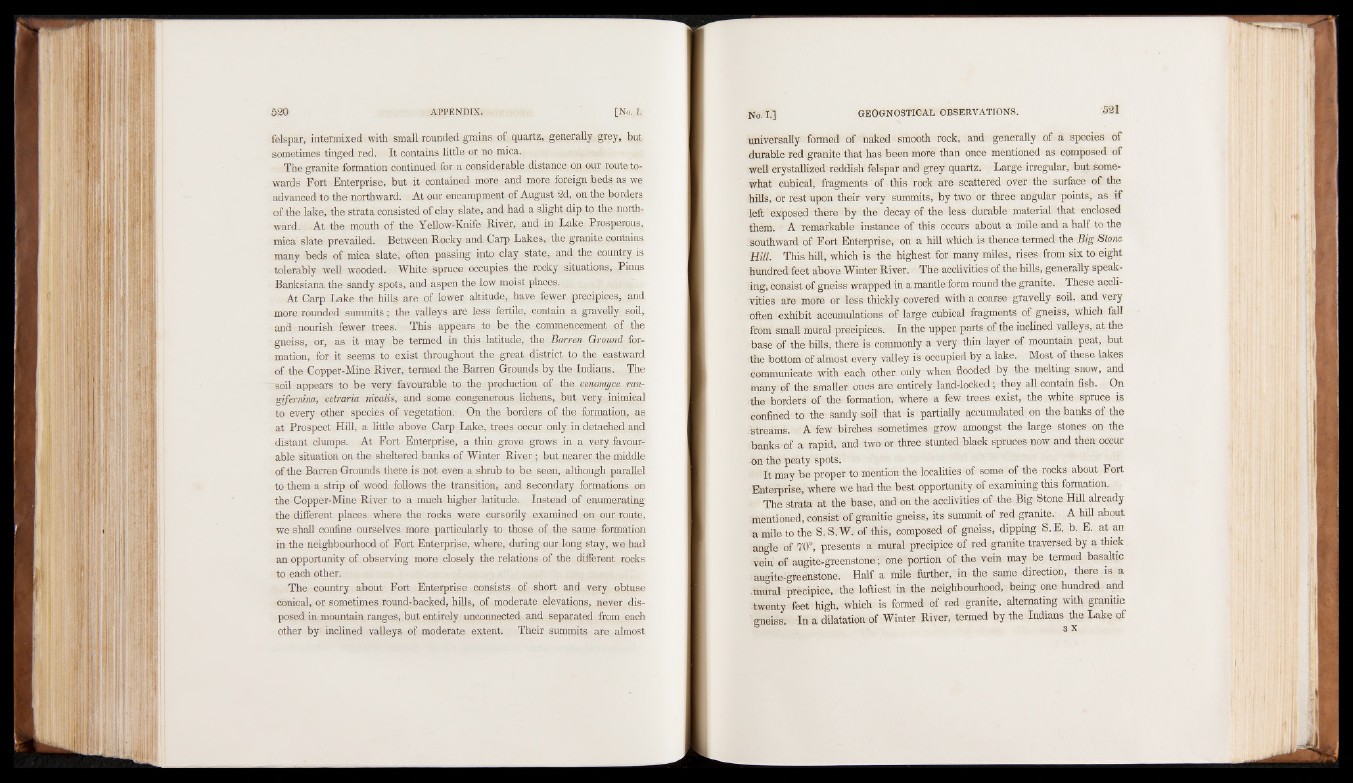
felspar, intermixed with small rounded grains of quartz, generally grey, but
sometimes tinged red. It contains little or no mica.
The granite formation continued for a considerable distance on our route towards
Fort Enterprise, but it contained more and more foreign beds as we
advanced to the northward. At our encampment of August 2d, on the borders
of the lake, the strata consisted of clay slate, and had a slight dip to the northward.
At the mouth of the Yellow-Knife River, and in Lake Prosperous,
mica slate prevailed. Between Rocky and Carp Lakes, the granite contains
many beds of mica slate, often passing into clay state,, and the country is
tolerably well wooded.- White. spruce occupies the- rocky situations, Pinus
Banksiana the sandy spots, and aspen the low moist places.
At Carp Lake the hills are of lower altitude, have fewer precipices, ,and
more rounded summits; the valleys are less fertile, contain a gravelly soil,
and nourish fewer trees. This appears to be the commencement of the
gneiss, or, as it may be termed in this latitude, the Barren Ground formation,
for it seems to exist throughout the great district ,to the eastward
of the Copper-Mine River, termed the Barren Grounds by the Indians. The
“soil appears to be very favourable to the production of the cenornyee.ran-
gifernina, cetraria nivalis, and some congenerous lichens, :,but very inimical
to every other species of vegetation. On the borders of the formation, as
at Prospect Hill, a little above Carp Lake, trees occur only in detached and
distant clumps. At Fort Enterprise, a thin grove grows in a. very favourable
situation on the sheltered banks of Winter River ; but nearer the middle
of the Barren Grounds there is not even a shrub to be seen, jalthough parallel
to them a strip of wood follows the transition, and secondary formations..on
the Copper-Mine River to a much higher latitude. Instead of enumerating
the different places where the rocks were cursorily examined on our route,
we shall confine ourselves more particularly to those of the same formation
in the neighbourhood of Fort Enterprise, where, during our long stay, we had
an opportunity of . observing more closely the relations of the different rocks
to each other.
The country about Fort Enterprise consists of short and very obtuse
conical, or sometimes round-backed, hills, of moderate elevations, never disposed
in mountain ranges, but entirely unconnected and separated from each
other by inclined valleys of moderate extent. Their summits are almost
universally formed of naked smooth rock, and generally of a species of
durable red granite that has been more than once mentioned as composed of
well crystallized reddish felspar and grey quartz. Large irregular, but somewhat
cubical, fragments of this rock are scattered over the surface of the
hills, or rest upon their very summits, by two or three angular points, as if
left exposed there by the decay of the less durable material that enclosed
them. A remarkable instance of this occurs about a mile and a half to the
southward of Fort Enterprise, on a hill which is thence termed the Big Stone
Hill. This hill, which is the highest for many miles, rises from six to eight
hundred feet above Winter River. The acclivities of the hills, generally speaking,
consist of gneiss wrapped in a mantle form round the granite. These acclivities
are more or less thickly covered with a coarse gravelly soil, and very
often exhibit accumulations of large cubical fragments of gneiss, which fall
from small mural precipices. In the upper parts of the inclined valleys, at the
base of the hills, there is commonly a very thin layer of mountain peat, but
the bottom of almost every valley is occupied by a lake. Most of these lakes
communicate with each other only when flooded by the melting snow, and
many of the smaller ones are entirely land-locked ; they all contain fish. On
the borders of the formation, where a few trees exist, the white spruce is
confined to the sandy soil that is partially accumulated on the banks of the
streams. A few birches sometimes grow amongst the large stones on the
banks of a rapid, and two or three stunted black spruces now and then occur
OnI tth me apye abtye psprooptse.r to mention the localities of some of the rocks about Fort
Enterprise, where we had the best opportunity of examining this formation.
The strata at the base, and on the acclivities of the Big Stone Hill already
mentioned, consist'of granitic gneiss, its summit of red granite. A hill about
a mile to the S.S.W. of this, composed of gneiss, dipping S.E. b. E. at an
angle of 70°, presents a mural precipice of red granite traversed by a thick
vein of augite-greenstone ; one portion of the vein may be termed basaltic
augite-greenstone. Half a mile further, in the same direction, there is a
mural précipice, the loftiest in the neighbourhood, being one hundred and
twenty feet high, which is formed of red granite, alternating with granitic
gneiss. In a dilatation of Winter River, termed by the Indians the Lake of